The AMD Ryzen 9 3950X Review: 16 Cores on 7nm with PCIe 4.0
by Dr. Ian Cutress on November 14, 2019 9:00 AM ESTCPU Performance: Web and Legacy Tests
While more the focus of low-end and small form factor systems, web-based benchmarks are notoriously difficult to standardize. Modern web browsers are frequently updated, with no recourse to disable those updates, and as such there is difficulty in keeping a common platform. The fast paced nature of browser development means that version numbers (and performance) can change from week to week. Despite this, web tests are often a good measure of user experience: a lot of what most office work is today revolves around web applications, particularly email and office apps, but also interfaces and development environments. Our web tests include some of the industry standard tests, as well as a few popular but older tests.
We have also included our legacy benchmarks in this section, representing a stack of older code for popular benchmarks.
All of our benchmark results can also be found in our benchmark engine, Bench.
WebXPRT 3: Modern Real-World Web Tasks, including AI
The company behind the XPRT test suites, Principled Technologies, has recently released the latest web-test, and rather than attach a year to the name have just called it ‘3’. This latest test (as we started the suite) has built upon and developed the ethos of previous tests: user interaction, office compute, graph generation, list sorting, HTML5, image manipulation, and even goes as far as some AI testing.
For our benchmark, we run the standard test which goes through the benchmark list seven times and provides a final result. We run this standard test four times, and take an average.
Users can access the WebXPRT test at http://principledtechnologies.com/benchmarkxprt/webxprt/
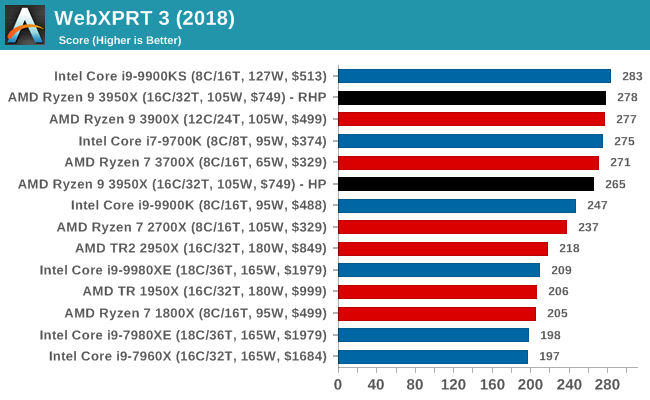
WebXPRT 2015: HTML5 and Javascript Web UX Testing
The older version of WebXPRT is the 2015 edition, which focuses on a slightly different set of web technologies and frameworks that are in use today. This is still a relevant test, especially for users interacting with not-the-latest web applications in the market, of which there are a lot. Web framework development is often very quick but with high turnover, meaning that frameworks are quickly developed, built-upon, used, and then developers move on to the next, and adjusting an application to a new framework is a difficult arduous task, especially with rapid development cycles. This leaves a lot of applications as ‘fixed-in-time’, and relevant to user experience for many years.
Similar to WebXPRT3, the main benchmark is a sectional run repeated seven times, with a final score. We repeat the whole thing four times, and average those final scores.
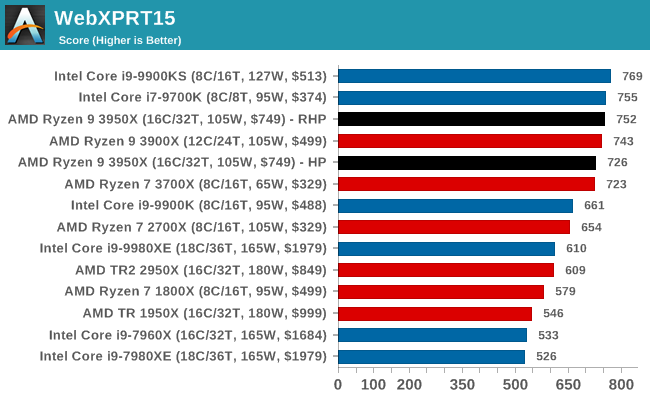
Speedometer 2: JavaScript Frameworks
Our newest web test is Speedometer 2, which is a accrued test over a series of javascript frameworks to do three simple things: built a list, enable each item in the list, and remove the list. All the frameworks implement the same visual cues, but obviously apply them from different coding angles.
Our test goes through the list of frameworks, and produces a final score indicative of ‘rpm’, one of the benchmarks internal metrics. We report this final score.
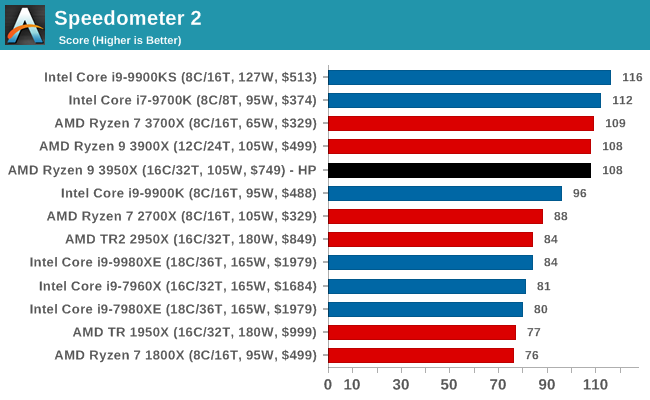
Google Octane 2.0: Core Web Compute
A popular web test for several years, but now no longer being updated, is Octane, developed by Google. Version 2.0 of the test performs the best part of two-dozen compute related tasks, such as regular expressions, cryptography, ray tracing, emulation, and Navier-Stokes physics calculations.
The test gives each sub-test a score and produces a geometric mean of the set as a final result. We run the full benchmark four times, and average the final results.

Mozilla Kraken 1.1: Core Web Compute
Even older than Octane is Kraken, this time developed by Mozilla. This is an older test that does similar computational mechanics, such as audio processing or image filtering. Kraken seems to produce a highly variable result depending on the browser version, as it is a test that is keenly optimized for.
The main benchmark runs through each of the sub-tests ten times and produces an average time to completion for each loop, given in milliseconds. We run the full benchmark four times and take an average of the time taken.

3DPM v1: Naïve Code Variant of 3DPM v2.1
The first legacy test in the suite is the first version of our 3DPM benchmark. This is the ultimate naïve version of the code, as if it was written by scientist with no knowledge of how computer hardware, compilers, or optimization works (which in fact, it was at the start). This represents a large body of scientific simulation out in the wild, where getting the answer is more important than it being fast (getting a result in 4 days is acceptable if it’s correct, rather than sending someone away for a year to learn to code and getting the result in 5 minutes).
In this version, the only real optimization was in the compiler flags (-O2, -fp:fast), compiling it in release mode, and enabling OpenMP in the main compute loops. The loops were not configured for function size, and one of the key slowdowns is false sharing in the cache. It also has long dependency chains based on the random number generation, which leads to relatively poor performance on specific compute microarchitectures.
3DPM v1 can be downloaded with our 3DPM v2 code here: 3DPMv2.1.rar (13.0 MB)
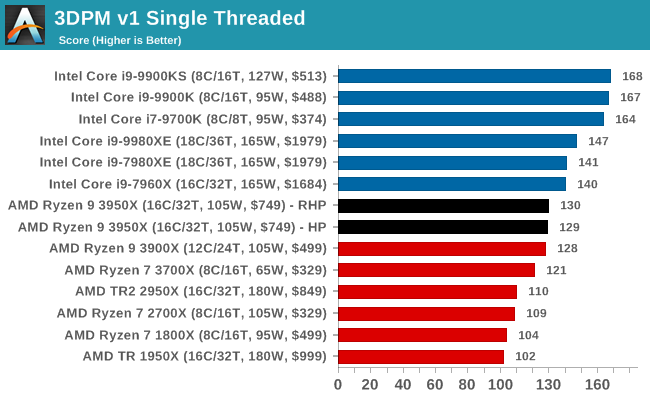
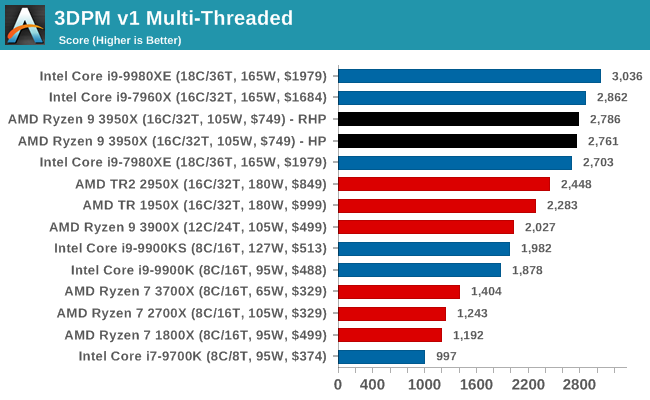
x264 HD 3.0: Older Transcode Test
This transcoding test is super old, and was used by Anand back in the day of Pentium 4 and Athlon II processors. Here a standardized 720p video is transcoded with a two-pass conversion, with the benchmark showing the frames-per-second of each pass. This benchmark is single-threaded, and between some micro-architectures we seem to actually hit an instructions-per-clock wall.
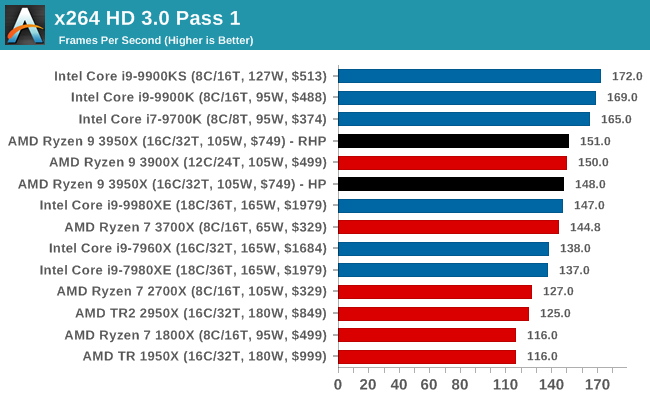
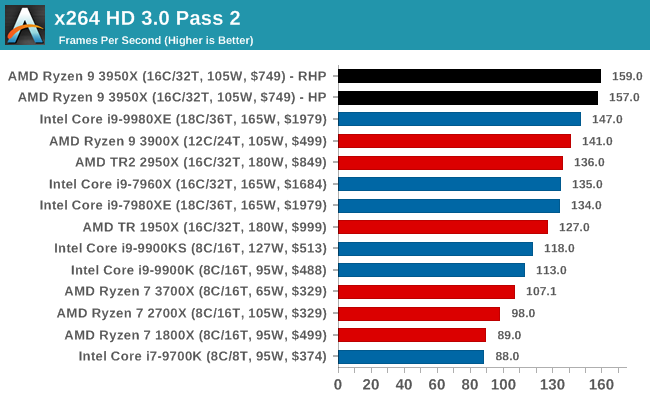
GeekBench4: Synthetics
A common tool for cross-platform testing between mobile, PC, and Mac, GeekBench 4 is an ultimate exercise in synthetic testing across a range of algorithms looking for peak throughput. Tests include encryption, compression, fast Fourier transform, memory operations, n-body physics, matrix operations, histogram manipulation, and HTML parsing.
I’m including this test due to popular demand, although the results do come across as overly synthetic, and a lot of users often put a lot of weight behind the test due to the fact that it is compiled across different platforms (although with different compilers).
We record the main subtest scores (Crypto, Integer, Floating Point, Memory) in our benchmark database, but for the review we post the overall single and multi-threaded results.

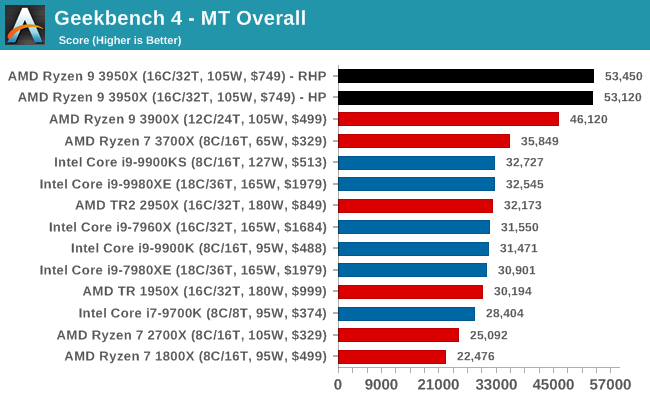










206 Comments
View All Comments
Spunjji - Thursday, November 14, 2019 - link
In theory it might be. In practice, they're still only able to make mobile CPUs with 4 cores or less on it.Orange_Swan - Thursday, November 14, 2019 - link
Nah, they've got at least one 6core/12thread, 15/25w mobile CPU, the Core i7-10710URetycint - Thursday, November 14, 2019 - link
That's 14nm. All Intel's 10nm processors so far have been limited to 4 core Ice Lake U processorsSmartcom5 - Friday, November 15, 2019 - link
If, and that's the whole issue here since a while now, IF Intel's 10nm would be working after all.Sure enough, that's a requirement which still needs to be fulfilled yet. The best process – no matter how oh so advanced it is going to be (on paper) – is worth exactly no·thing if it ain't working. Then, even a (on paper inferior) node is superior, since it at least meets a crucial condition; It's working (already).Thus, it isn't anymore. They relaxed it quite a bit in 2017 to make it work, that's it.
Intel's actual 10nm which spawned Ice Lake isn't the same as it was before, that's why it's coined 10nm+. It's actually less dense than Intel's initial and original-10nm which brought Cannonlake – density was toned down, it's more like ~12nm now.
Interestingly TSMC on its current 7nm N7-process already archives virtually the very same density Intel failed to archive on their initial 10nm-process back then – while their current 10nm+, which has a toned-down density from initially 2.7× down to only some 2.0—2.2× (depending on what sources you're willing to trust), is rumoured to rather equal some 12nm-ish alike process instead of being closer to any initial Intel'ian 10nm.
So while Intel somehow failed, others archived the same density-goals Intel was trying to do for years, to no greater avail – and those others where even on track as scheduled most of the time. Thus, TSMC already fabs on a process which would equal Intel's very initial 10nm-process, which never really saw any greater light of day, bar that known i3-8121U (well, and that m3-8114Y of course, ... you don't know a thing about it, okay?).
GraveNoX - Thursday, November 14, 2019 - link
Yes, they will launch 10nm and 7nm on the same day so you have the freedom to choose which version of the chip you want.Oliseo - Thursday, November 14, 2019 - link
"Based on my imagination Intel will destroy AMD"Santoval - Thursday, November 14, 2019 - link
It is meaningless to compare Intel's 7nm parts, which will be released in 2021 assuming NO delays (thus more realistically in 2022+) with AMD's current 7nm parts. If you were going for a "node for node" comparison that is even more meaningless, because Intel's 7nm node will be equivalent to TSMC's 4nm or 5nm node in transistor density (I have read numbers predicting ~185 million transistors per mm^2 for TSMC's 5nm node and ~200nm MTr/mm^2 for Intel's 7nm node). TSMC's 5nm node will almost certainly be released before Intel's 7nm node by the way.Regarding Intel's 10nm node parts, while Sunny Cove appears to have a higher IPC than Zen 2 Intel's 10nm parts suffer from much lower clocks which have eaten away all or almost all the IPC gains. This is why Intel have not announced an Ice Lake-S/H release and intend to replace it with Comet Lake-S/H. S/H parts require high clocks, which cannot be provided by Intel's 10nm+ node due to very low yields at high clocks. Only low power Ice Lake-U/Y parts and Ice Lake Xeons will be released. Why? Because these parts have lower clocks.
More or less the same thing might be repeated with Tiger Lake, in 2H 2020, which would mean that Intel are not very confident of fixing their 10nm node issues even with their 10nm++ node variant. It is rumored that there will be no Tiger Lake-S/H parts and Rocket Lake-S/H will take their place. What's Rocket Lake? A 14nm+++++++ part but with a new μarch (Sunny or Willow Cove cores and a Gen11 or Gen12 iGPU).
Santoval - Thursday, November 14, 2019 - link
edit : "and ~200 MTr/mm^2 for Intel's 7nm node".Targon - Thursday, November 14, 2019 - link
Didn't TSMC start 5nm risk production a month or so ago?John_M - Monday, November 25, 2019 - link
Yes, they did.